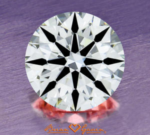What Are VVS Diamonds and When Should You Buy Them?
VVS Diamonds are some of the rarest diamonds available in terms of clarity grade. VVS stands for Very, Very, Slightly Included and this clarity grade is further broken down into two sub-categories including: VVS1 and VVS2. Where does this clarity grade fit into the diamond clarity spectrum and when does it makes sense to purchase a VVS1 or VVS2 diamond?
Understanding Rarity For Diamond Clarity Grades
Diamond value and pricing is largely determined by carat weight and rarity of clarity and color grade characteristics. A perfectly pristine diamond with absolutely no flaws is a Flawless diamond. These are extremely rare and almost never worn in jewelry. Diamonds of this clarity grade are purchased for investment or collection.
Next we have an Internally Flawless diamonds where the imperfections are found inside the diamond and are called inclusions. These are extremely difficult to see under 10x’s magnification and would never be visible with the naked eye.
After Flawless and Internally Flawless we come to VVS1 and VVS2 clarity grades. At this clarity grade a diamond could have internal inclusions or external blemishes, however neither of which would be visible without the aid of a powerful microscope. The average jeweler using a 10x’s magnified loupe will have extreme difficulty in locating any inclusions or blemishes in diamonds of this clarity grade and therefore these are an excellent option for individuals looking for as close to perfection as possible without having to pay for an extremely rare Flawless or Internally Flawless diamond.
When Can You See Visible Imperfections In A Diamond?
Since diamonds are graded using 10x’s magnification, most diamonds will not show visible flaws unless they have an SI1 or lower clarity grade. Some VS2’s may show a visible inclusion depending on what and where it is in the diamond. Clarity grading is an art and not a science and since every diamond is unique, each clarity grade designation will have various factors in mind when determining what grade it should receive. Suffice it to say that a VVS1 or VVS2 will never show any inclusions or blemishes to the unaided eye and often times you will have great difficulty detecting any imperfection even with magnification.

From Left: 1.02ct E IF, 1.01ct E VVS1, 1.01ct E VS2, and 1.02ct E SI2 Prices From Left: $5,055.00, $4,539.00, $3,983.00, and $3,470.00
What Is The Difference Between VVS1 and VVS2?
The sub-categories of VVS1 and VVS2 is a distinction more for the lab and less for the consumer, however what IS important is the slight cost savings implied. Since neither of these clarity grades show any visible imperfections, the consumer should not be concerned with one being better than the other but rather focus on price as a final determinant.
When Should You Consider Buying A VVS1 or VVS2 Diamond?
When you start your diamond search you usually have a diamond shape, carat weight and budget in mind at a minimum. These are the three biggest factors when looking for a suitable diamond and help to narrow your diamond options as you search online. Considering cut grade is always ideal (for maximum brilliance/fire and resulting sparkle), you may consider purchasing a high clarity VVS1 or VVS2 if a diamond happens to be available. The most important consideration when purchasing your diamond is that it fits your budget and has been cut well enough to show it’s beautiful sparkle. If a VVS1 or VVS2 diamond falls within your final list of options you can consider this icing on the cake.
As always, if you have any diamond buying questions or would like some personal diamond recommendations, please don’t hesitate to contact me. If you are shy and would rather get on the weekly list of diamond recommendations, be sure to sign up to ODBA’s Diamond Deal Friday.
Happy Diamond Buying!
Liz
Hey.You Want Ideal Cut Diamonds?
You've got it.
Join ODBA's Diamond Deal Friday and get handpicked diamonds every week from me to you.
No consultation required. Subscribe now!
ODBA Recommends
You May Also Like






